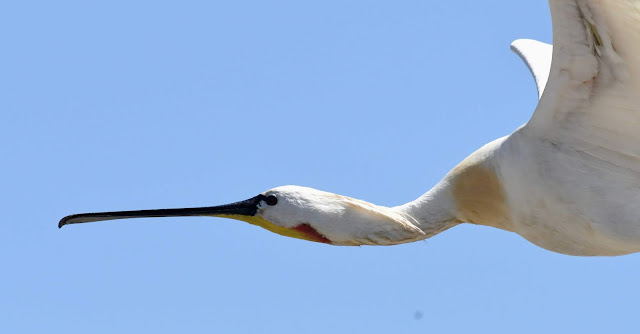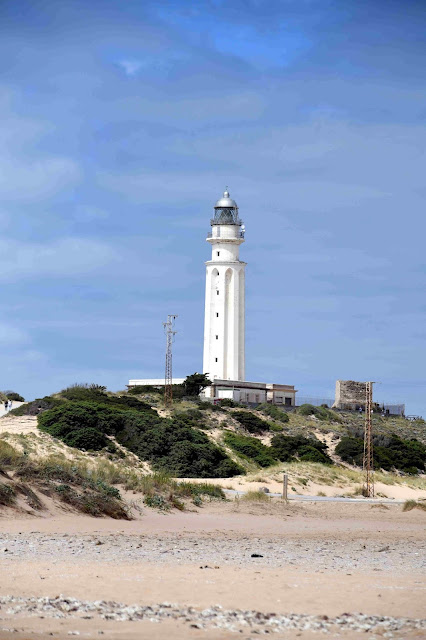(saapumispäivän näkymä kämpän parvekkeelta lahdelle )
Parin viikon retki kesti puolta tuntia
vaille 340 tuntia.
Perillä ajoimme autolla 1500
kilometriä ja kävelimme 260 kilometriä, retkipäivää kohti siis
noin 107 kilometriä ajoa ja 18,5 kilometriä kävelyä. Koska mukana
ovat myös siirtoajot Malagasta San Fernandoon ja takaisin,
todellinen päivittäinen ajomatka San Fernandossa vietettynä aikana
jäi selvästi pienemmäksi. Auton vuokrasimme samasta paikasta kuin
edeltävälläkin kerralla. Record Go:lla on 2000 kilometrin raja
johon mennessä auto pitää tuoda vuokraamoon tarkistettavaksi, muuten joutuu maksamaan ylikilometrikohtaista lisähintaa.
Viikon retkellä tuo ei ylity, mutta tällä kahden viikon retkellä
pidimme tuota kilometrikertymää silmällä ettei se ylity, varmasti
ihan vapaasti ajaen olisi voinut tulla enemmänkin matkaa. Meillä
oli molemmilla kerroilla myös lisävakuutus joka säästi meidät
lisälaskujen harmilta. Tässä autossa takana olevan rekisterikilven
kiinnitys osoittautui epävarmaksi, jouduimme korjaamaan sitä
ajettuamme Algaidan mäntymetsän ympäristön kuoppaisilla teillä.
Siitä olisi laskua tarjottu ilman tuota lisävakuutusta, kävi ilmi
kun asiasta vuokraamolle ilmoitin. Kun vielä palautimme auton
takaisin täyteen tankattuna, saimme parissa päivässä takaisin
siitäkin vuokratessa tehdyn katevarauksen.
( näkymää Punta Canteran suunnasta kauppakeskukseen ja hotelliin päin )
Lajeja retkellä näimme 135,
päivittäin viidenkymmenen kahta puolta. Kun vuosi sitten
tekemällämme viikon retkellä näkyi noin 20 sellaista lajia joita
nyt emme nähneet, epävirallinen maalistamme on tällä hetkellä
155 lajin mittainen. Jos tuota vertaan Suomen maalistani
kehittymiseen, saman verran lajeja minulla oli Suomesta vuonna 1967
eli noin kuusi vuotta ensimerkinnöistä ja neljän aktiivisemman harrastusvuoden jälkeen. Toisaalta tämän
vuoden aikana olen nähnyt Suomessa jo tuota enemmän lajeja, tuo
määrä on koossa tyypillisesti toukokuun alussa, bongaamalla
nopeamminkin.
Runsas kävely näkyi myös kunnossa,
molemmilla putosi painosta tuon kahden viikon aikana kolme kiloa.
Valokuvia otin retken aikana noin 4900.
Äänityksiä puhelimella tein noin 30 ja videoita Coolpix P 1000:lla
suunnilleen saman verran. Niiden parissa menee vielä paljon aikaa.
(espanjalainen käsitys mäntymetsästä on tämä )
San Fernando vaikutti mukavalta
paikalta, on meidän makuumme sopivan kokoinen, matkailijat
pääasiassa kai kotimaasta, muuta kuin espanjaa ei kaduilla juuri
kuule. Sijaintimme oli hyvä, kaupat pääasiassa alakerrassa ja
retkelle pääsi välittömästi kun tuli ulos ostoskeskuksen
alueelta. Hotellin ja ostoskeskuksen alueelta löytyi aina
parkkitilaa. Liikenne oli vilkasta mutta joustavuutta oli enemmän
kuin meillä kotimaassa, se sieti välttämättömät noviisin
mokatkin joita ensialkuun tuli. Tosin joukossa erityisesti pääteillä oli tietysti niitä pakollisia alonsoja mutta niihinkin tottui.
Retkikohteemme valitsimme John Cantelon
nuottikirjasta kämpällä valmiiksi ja nuotituksen tarkemmat
yksityiskohdat kohteiden läheltä luimme myös. Mukana oli myös kirja Where to Watch Birds in Southern & Western Spain, kolmas painos, mutta se esitteli vain osaa noista paikoista. Käytännön
suunnistusapuna siirtymätaipaleilla meillä oli Google Maps, joka
toimi hyvin Seijan puhelimessa. Minun puhelimeni oli taas aivan pimeä
joka puolella hotellin ulkopuolella, edes offline-kartat eivät
suostuneet latautumaan. Meillä on eri operaattori ja hänen
käyttämällään tuntuu olevan ylivoimaiset roaming-sopimukset.
Seuraavalla pidemmällä retkellä taidan hankkia puhelimeeni tai
ehkä paremmin vielä erilliseen tablettiin paikallisen
prepaid-simin. Navigointi söi Seijan puhelimella paljon virtaa ja
puhelin uhkasi tyhjentyä pidemmillä matkoilla vaikka se oli koko
ajon ajan autolaturissa kiinni. Hotellilla oli oma WiFi-verkkonsa
mutta se se toimi aika epävarmasti, välillä sielläkin olimme vain
Seijan puhelimen varassa ja sen WiFiä jouduimme sitten jakamaan sekä
hänen tietokoneeseensa (missä olivat nuo John Cantelon retkivinkit)
että minun puhelimeeni. Ylimääräisiä datamaksuja emme kuitenkaan
laskuillemme saaneet, kiintiöt pitivät hyvin.
( palailemme pimeän tultua linnoitukselta hotellille )
Polkuverkosto tuolla oli erinomainen,
keskittymällä pelkästään niihin näkee jo valtavan paljon.
Ihmiset tuntuvat harrastavan liikuntaa paljon, ja liikkujat ovat
selvästi hyväkuntoisia. Pyöräillään lihasvoimalla reippaasti
kun täällä ylipainoiset puurtajat tuntuvat käyttävän vain
sähköpyöriä. Ihmiset tuntuivat olevan mukavia ja asiat hoituivat
helposti kielimuurista huolimatta. Tosin jotakin outoa meissä kai on
koskapa nyt jo molemmilla retkillä tulli on ottanut meidät
perusteelliseen tarkastukseen, tosin tällä kertaa en sentään
joutunut ihan ruumiintarkastukseen, vain tavarat käytiin
yksityiskohtaisesti läpi.
***
( Cadiz olisi ollut tällainen perinteisempi rantalomapaikka, sopi päiväretkelle ja sekin olisi ollut parasta tehdä junalla, matkaa San Fernandosta vain pari pysäkinväliä )
In english:
The
two-week trip lasted half an hour to 340 hours.
We
drove 1,500 kilometers by car and walked 260 kilometers, so we travel
about 107 kilometers using car and 18.5 kilometers of walking per
day. Since the transfer from Malaga to San Fernando and back is also
included, the actual daily journey during the time spent in San
Fernando was clearly smaller. We rented the car from the same place
as before. Record Go has a 2000-kilometer limit, after which the car
must be brought to the rental office for review. One week's excursion
is not likely to produce problems, but on this two-week excursion, we
kept that mileage in mind, surely without that limit would have been
possible to travel more. We also had additional insurance on both
occasions, which saved us from the inconvenience of additional bills.
The fixing of the license plate behind this car proved to be
uncertain,we had to fix it after driving on the bumpy roads of the
Algaida pine forest. It would have been billed without that
additional insurance, it turned out when I informed the rental
company. When we returned the car back to full refueling, we got back
in a couple of days when we rented the roof reservation.
On
the excursion we saw 134 species. Last year on a one week trip we saw
about 21 species that we didn't see now, so our unofficial list in
Spain is 155 species. Compared to my life-list development from
Finland, I had the same number of species in Finland in 1967, first
markings in 1961 and some four years of more dedicated hobby. On the
other hand this year I have seen in Finland already more species,
typically at the beginning of May, if twitching, then sooner.
Ample
walking was also seen in good condition, both dropping three kilos of
weight in that two weeks.
I
took about 4900 photos during the trip. I made about 30 song
recordings on the phone and the videos taken on Coolpix P1000 were about
the same. They still take a lot time to go through.
San
Fernando seemed like a nice place, it had the right size for our
taste, the tourists mainly from Spain, other than the Spanish, just
can't hear in the streets. Our location was good, the shops were
downstairs and the excursion could start immediately as we came out
of the mall. There was always parking space in the hotel and shopping
center area. The traffic was lively, but more flexibility than we had
in our country, it tolerated the necessary novice's mistakes that
came first until we got acquainted with town.
Our
excursion destinations we selected from John Cantelo's note book, and
details of the approach near the objects were also read. We had
Google Maps, which worked well on Seija's phone, as a practical
navigation aid for the transition. My phone was again quite useless
everywhere outside the hotel, even offline maps did not agree to
download. We have a different operator and her's seems to have superior
roaming agreements. On the next long trip, I think I can buy in my
phone or maybe even in a separate tablet a local prepaid card.
Navigation ate a lot of power on the phone of Seija and the phone
threatened to drain on longer trips even though it was closed in the
car charger for the entire duration of the trip. The hotel had its
own WiFi network but it was pretty uncertain, sometimes there we were
only on Seija's phone and we had to share it with both her computer
(where were those John Cantelo tips) and my phone. However, we did
not receive any extra data charges on our invoices, the quotas kept
well.
The
trail network was excellent there, focusing on them alone saw a huge
amount. People seem to be doing a lot of exercise, and people are
clearly in good shape, biking with muscle strength briskly when here at home
overweight drills seem to use only electric bikes. People seemed
comfortable, friendly and things were easy to handle despite the language
barrier. Of course, something strange about us now is, as on both
trips the customs has taken us to an intensive inspection. This
time I never got into a thorough body check as on previous trip, only the goods went through the
detail.
***










































